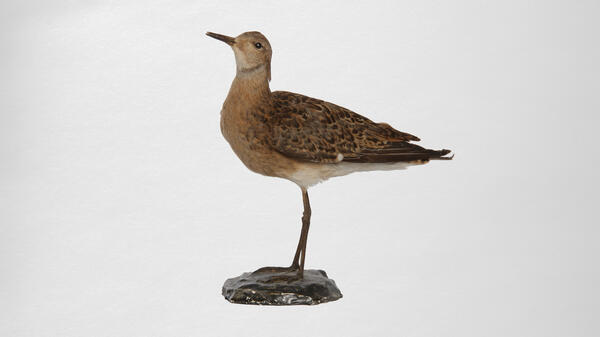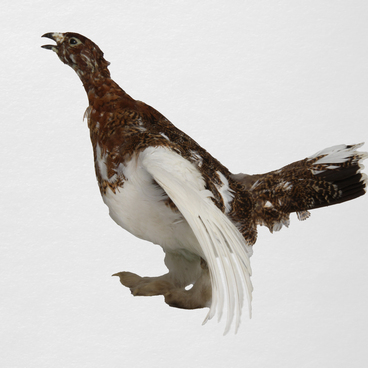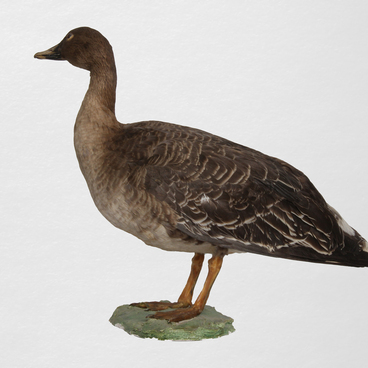The curlew sandpiper belongs to the Sandpiper family (Scolopacidae). It nests in the coastal zones of the Arctic tundra in the northern part of Siberia, including in the Yamalo-Nenets Autonomous District. The bird winters in West Africa — it gets there through continental Europe and the Mediterranean.
The curlew sandpiper is distinguished by its small size and calm character. Females and males are similar in size and color of plumage; females are slightly paler than males. The average weight of an adult bird is 53–91 grams; their body length is about 20 centimeters. The beak of the curlew sandpiper, like all sandpipers, is long — it can reach 41 centimeters.
The curlew sandpiper is often confused with its relative, the dunlin. The latter can be distinguished by its smaller size and the beak that is not so noticeably curved. The legs of the dunlin remain black both in winter and in breeding plumage.
The curlew sandpiper is especially easy to recognize in its breeding plumage. In the lower part of the body, it has a rich chestnut-red color. The red knot has a similar color, but it is larger than the curlew sandpiper and usually does not live far off the shore.
Also the curlew sandpiper can be distinguished from the dunlin by its voice. The male, sitting on the ground, makes a short squeaky sound from time to time, and chirps quickly when it flies. During mating, the male curlew sandpiper first makes a rather slow creaking sound, then — a fast rattling trill, which sounds like “dyurri” or “dirrit”. The mating trill of the dunlin sounds harder — like “trria.”
The curlew sandpiper has long, pointed and rather narrow wings. The first flight feather forms the apex of the wing, the second is not much shorter than the first, but the third is much shorter than the second. The tail of the bird is squared; the middle tail feathers are slightly longer than the rest. The curlew sandpiper flies well over long distances and actively runs on the ground while feeding. The curlew sandpiper makes 50 to 80 steps per minute, pecking out food every three to five steps.
The curlew sandpipers feed on adult insects — beetles and mosquitoes — as well as on larvae and worms. During long-distance flights, those birds that keep along the sea coastlines feed mainly on small crustaceans, for example, amphipods; sometimes they eat small mollusks, and often eat plant foods. The curlew sandpipers feed mainly in small flocks, rarely gathering in flocks of 100–200 individuals.
The curlew sandpiper is distinguished by its small size and calm character. Females and males are similar in size and color of plumage; females are slightly paler than males. The average weight of an adult bird is 53–91 grams; their body length is about 20 centimeters. The beak of the curlew sandpiper, like all sandpipers, is long — it can reach 41 centimeters.
The curlew sandpiper is often confused with its relative, the dunlin. The latter can be distinguished by its smaller size and the beak that is not so noticeably curved. The legs of the dunlin remain black both in winter and in breeding plumage.
The curlew sandpiper is especially easy to recognize in its breeding plumage. In the lower part of the body, it has a rich chestnut-red color. The red knot has a similar color, but it is larger than the curlew sandpiper and usually does not live far off the shore.
Also the curlew sandpiper can be distinguished from the dunlin by its voice. The male, sitting on the ground, makes a short squeaky sound from time to time, and chirps quickly when it flies. During mating, the male curlew sandpiper first makes a rather slow creaking sound, then — a fast rattling trill, which sounds like “dyurri” or “dirrit”. The mating trill of the dunlin sounds harder — like “trria.”
The curlew sandpiper has long, pointed and rather narrow wings. The first flight feather forms the apex of the wing, the second is not much shorter than the first, but the third is much shorter than the second. The tail of the bird is squared; the middle tail feathers are slightly longer than the rest. The curlew sandpiper flies well over long distances and actively runs on the ground while feeding. The curlew sandpiper makes 50 to 80 steps per minute, pecking out food every three to five steps.
The curlew sandpipers feed on adult insects — beetles and mosquitoes — as well as on larvae and worms. During long-distance flights, those birds that keep along the sea coastlines feed mainly on small crustaceans, for example, amphipods; sometimes they eat small mollusks, and often eat plant foods. The curlew sandpipers feed mainly in small flocks, rarely gathering in flocks of 100–200 individuals.



